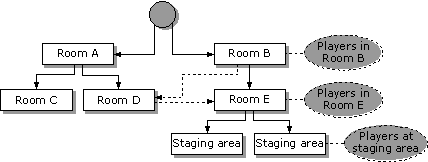
A lobby session closely resembles a DirectPlay client/server session (see the illustration in Client/Server Session). The term lobby session refers to a connection to a lobby server where clients and the server have not been specifically written to interoperate. The term application session refers to a traditional DirectPlay session in which all the clients and the server (if any) have been specifically written to interoperate.
A DirectPlay lobby session is used to represent a connection to a lobby server. Like a DirectPlay application, the first step in using DirectPlay to communicate with a lobby server is to select which lobby provider to use and which lobby server to connect to. Like a DirectPlay application, the IDirectPlay3::EnumConnections and IDirectPlay3::InitializeConnection methods are used to do this.
The lobby client uses the same session management methods as an application client to locate and to join a lobby session; for example, EnumSessions, Open, SecureOpen, and Close. Joining a lobby session gives the client application access to all the information on the lobby server and enables the user to interact with other users on the lobby server.
Like a DirectPlay application session, the player is the basic entity in a lobby session. Each player represents a user on a client computer connected to the lobby server. There is also the server player representing the lobby server. Once a lobby client connects to a lobby server (by joining the lobby session), it must establish the user's presence by creating a player and adding the player to an initial group before the player can start communicating with the server and other players. In fact, other users connected to the session won't even be aware of the new user's presence until this happens.
The same player management methods used by application sessions are used to manage players in a lobby session; for example, EnumPlayers, CreatePlayer, DestroyPlayer, GetPlayerName, SetPlayerName, and GetPlayerCaps.
Unlike a DirectPlay application session, Send and Receive generally cannot be used to exchange messages with other players. In the DirectPlay lobby architecture, any application that uses the DirectPlay API can connect to any lobby server. This means that many different lobby client applications might be present in the same lobby session, all of which were written by different developers. Simply sending a message to another client player or the server player does not guarantee that it will be interpreted correctly by the recipient application.
Common functions that require communications between clients and the server have new methods created for them. DirectPlay determines the message's format. The recipient receives a system message containing the content of the message in a well-defined data structure. For example, the IDirectPlay3::SendChatMessage method sends a text chat message to another player.
Groups take on more significance in a lobby session, because they are used to define the organization of the entire lobby server and for launching application sessions. You can create a complete hierarchy of groups to manage and organize all the players and sessions that the lobby server tracks.
For the purposes of the lobby server, groups are classified as one of two types. A standard group can contain players and other groups and is called a room. A room is primarily used as a meeting place for players to interact with other players in the context of the lobby. The room contains links to other rooms and links to the second type of group - a staging area.
A staging area group typically contains only players. A staging area is used to marshal players together in order to launch a new session. Once the session has been launched, the staging area can remain in existence so that new players can join the session in progress.
Room groups are primarily organized in a hierarchical structure. A few top-level groups are created and other groups are created within existing groups. The lobby client can enumerate all the top-level groups as well as the groups contained within a group. The lobby server can also organize the groups in a web structure. Once a group is created, you can add it to another group, which creates a link between the two groups. When a lobby client enumerates groups within a group, all subgroups and linked groups are returned.
The following diagram illustrates the organization of a lobby session.

Players can only be seen in groups. They cannot be seen until they are part of a group. Players can belong to more than one group at once.